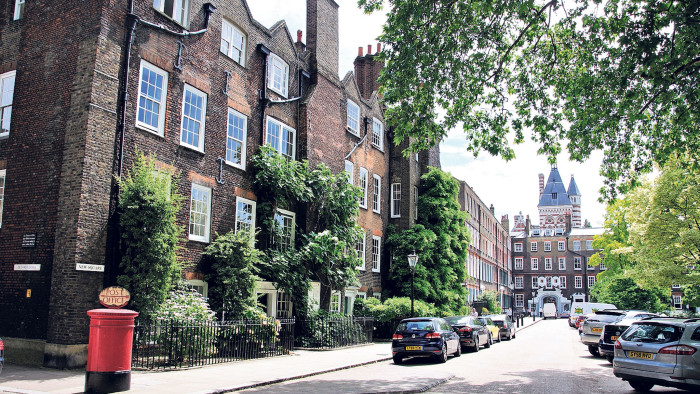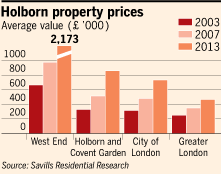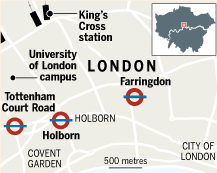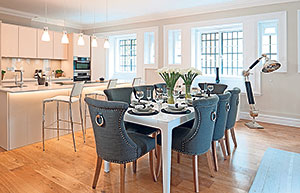Holborn outperforms better-known neighbours in central London

Simply sign up to the Life & Arts myFT Digest -- delivered directly to your inbox.
When Charles Dickens lodged in Holborn aged 22 the experience left such an impression on him that he later sent the hero of Great Expectations to board in the same area. And Philip Pirrip (Pip) memorably described his new lodgings as “the dingiest collection of shabby buildings ever squeezed together in a rank corner as a club for Tom-cats”.
Dickens’s former home, Furnival’s Inn, an establishment that provided collegiate-style bed and board for lawyers and legal students employed at the High Court, was demolished in 1897. Yet, Holborn’s reputation as a primarily commercial area with strong links to the legal profession persisted until much more recently when, with strong demand causing prime central London to stretch at the seams, its reputation as a convenient residential location, tucked between the City and the West End, became more widespread. Prices are now outperforming better-known neighbours, and developers are moving in to convert offices, warehouses and rundown blocks into high-end flats.
Sam Ball, sales manager at Frank Harris & Co estate agents, believes Holborn is benefiting from a “triple-ripple” effect. From the west, he says buyers are moving from prime central London, through the West End and towards Holborn. The regeneration of King’s Cross is driving them in from the north. And from the east, rising prices in the City are also encouraging buyers to consider Holborn.
“There is enormous demand for the area and properties are selling in a heartbeat,” says Ball. “I guess that property developers are seeing this, and seeing there is a profit margin, and that is why they are moving in.”
The most high-profile example of this was the announcement in February that Mumbai-based developer Lodha had bought the site of the London School of Business and Finance on Carey Street for £90m and was planning a residential development.

Holborn is too small to generate individual price data but, coupled with neighbouring Covent Garden, it is clear that prices in this area are steadily rising. According to research from Savills, prices have increased from an average £328,908 in 2003 to their current level of £861,120, an increase of 162 per cent.
This means the area is outperforming the City, where prices are up 132 per cent, and Bloomsbury, where they have risen 135 per cent. However, the Holborn and Covent Garden market is not as strong as the more established West End, where prices are up 226 per cent in the past decade to £2.2m.

Demand is coming from a mix of UK and international buyers. Holborn’s proximity to the University of London in Bloomsbury is another major factor in the area’s current in-demand status, according to Ball, particularly from overseas buyers interested in homes for their student offspring. Buy-to-let investors, meanwhile, like its low (by central London standards) entry prices and potential gross yields of about 4 per cent.
When it comes to owner-occupiers, Alex Dolley, branch manager of Greene & Co estate agents, says Holborn has always attracted lawyers and barristers. Now that more international companies are moving in (recent arrivals include Skype and Amazon), the legal professionals have been joined by senior managers. “There is a particularly high demand for one- and two-bedroom pied-à-terres,” says Dolley.
In the next few years the opening of Crossrail stations within walking distance (at Tottenham Court Road and Farringdon) will, Dolley believes, keep interest strong, as will buoyant confidence in the housing market. “People seem to have totally forgotten what happened in 2008,” he says. “There are so many buyers out there, so little property and lending is cheap. I can’t see how the market is going to soften in the next 12 months unless there is something like a rise in interest rates or we go to war with Russia.”
Holborn, like all of central London, suffers from the usual problems with traffic congestion. Dolley feels the area can be divided into two sides. Abutting the West End, it is more congested and noisy, and can be uncomfortably thronged with tourists. To the east, it is quieter – perhaps too quiet for some. “It is a bit like Clerkenwell: a Monday-to-Friday place, with some of the shops shut at weekends,” he says.

The area also lacks real heart. High Holborn has plenty of chain stores but lacks atmosphere. The area around Lambs Conduit Street is quietly improving, with some interesting independent shops and cafés (as well as the much-hyped People’s Supermarket, staffed by volunteers and supplying produce direct from farmers), but is not an urban village on a par with Marylebone or Notting Hill.
Finally, the choice of property is limited. There are a few pockets of freehold houses, notably around John Street, but these rarely come on the market. At present, choice is confined to a warehouse building converted into a four-bedroom house, priced at £4.4m with Frank Harris & Co.
The choice of flats is far better. Foxtons is selling a two-bedroom flat in a gated development on Three Cups Yard for £1.1m, while Savills has a penthouse in a former commercial building designed by Edwin Lutyens and overlooking Lincoln’s Inn, London’s largest public square. The duplex apartment is priced at £2.75m.
Half a mile to the south, the proposed “garden bridge” project by architect Thomas Heatherwick, which would link Temple with the South Bank, has attracted huge support, both public and political, and would give Holborn a further boost.
——————————————-
Buying guide
● Property prices in Holborn and Covent Garden are 67 per cent higher today than in 2007
● Holborn Tube station is on the Central and Piccadilly lines, and close to two new Crossrail stations that will offer direct links to Heathrow airport
● In 2013 there were 136.92 crimes reported per 1,000 people in the borough of Camden
What you can buy for . . .
£500,000 A one-bedroom flat above shops or offices
£1m A two-bedroom, penthouse flat with a roof terrace
£4m A four-bedroom, freehold period property
Comments